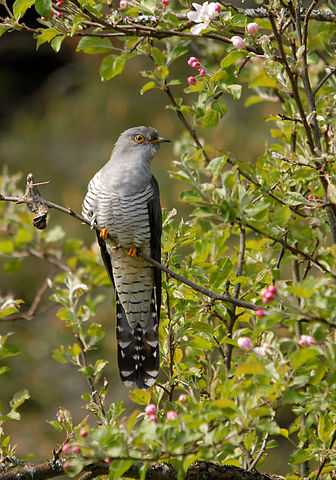Listening to the characteristic sound also brings a sense of awe, to think that this bird -about the same size as a pigeon- has flown all the way here to Scotland from central Africa. The call is the male bird, letting females in the area know that he has arrived and is ready to take a mate.
 |
| European Common Cuckoo (Cuculus canorus) Image: Locoguapa |
Cuckoos are brood parasites, a term that means rather than rearing their own chicks they lay an egg in the unattended nest of another bird, pushing out one of that birds own eggs in the process. The bird whose nest it is then unwittingly raises the cuckoo chick as it's own, unaware of the swap. The young cuckoo usually pushes it's foster brothers and sisters out of the nest, meaning it is the sole recipient of it's surrogate parents attentions. Cuckoos in Scotland usually lay their eggs in the nests of birds such as Meadow Pipits, Dunnocks, and Reed Warblers. The health of the population of Scottish and British cuckoo populations is therefore closely linked to those of these birds. The dramatic decline of cuckoos in recent years has largely been due to a reduction in their egg-hosts' populations decreasing, caused mainly by habitat loss and fragmentation.
The cuckoo has a breast patterning that mimics the coloration of the peregrine falcon and keeps potential competitors and predators at bay. This is the grey and white banding that you can see clearly in the picture above. It is though that this patterning also helps them to successfully parasitise the nests of other birds, fooling them into thinking that they are going to be attacked and eaten, and so they flee the nest leaving the female cuckoo free to lay her egg. Something which she can do in under 10 seconds!
 |
